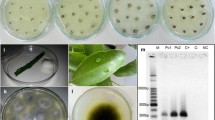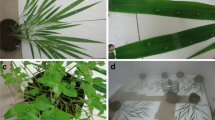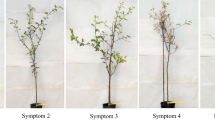Abstract
Survival- ofBotrytis cinerea was monitored during two summer seasons. Mycelium and conidia were found dead on the surface of plant debris within 2 months of incubation, whereas a high level of viability was detected in thallus of the pathogen which was 1–2 mm inside the dry host tissue. Of the 148 samples of infected senescing cucumber female fruits, 8% survived seven warm months; half of these isolates ofB. cinerea were resistant to dicarboximides (5 (µ/ml iprodione). Of the stems of cucumber infected withB. cinerea in winter, 18% yielded the pathogen at the beginning of the following winter; 15% of the surviving isolates were resistant to dicarboximides. Cucumber seedlings artificially infected byB. cinerea did not yield the pathogen longer than 9 weeks after establishment of infection, even when incubated in the shade. Plant debris with symptoms of gray mold were kept in the shade during the summer; at the beginning of winter it was possible to establish infection ofB. cinerea from the dry debris.
Similar content being viewed by others
References
Coley Smith, J.R. (1980) Sclerotia and other structures in survival, pp. 85–114.in: Coley Smith, J.R., Verhoeff, K. and Jarvis, W.R. [Eds.] The Biology of Bolrytis. Academic Press, London.
Elad, Y. (1988) Scanning electron microscopy of parasitism ofBotrytis cinerea on flowers and fruits of cucumber.Trans. Br. mycol. Soc. 91:185–190.
Elad, Y., Yunis, H. and Mahrer, Y. (1989) The effect of climatic conditions in polyethylene- covered structures on gray mold disease of winter cucumbers. Appl. agric. Res. 3 (in press):
Katan, T. (1982) Resistance to 3,5-dichlorophenyl-N-cyclicimide (‘Dicarboximide’) fungicides in the gray mold pathogenBotrytis cinerea on protected crops.PI. Path. 31:133–141.
Katan, T. (1982) Persistence of dicarboximide-fungicide resistance in populations ofBotrytis cinerea in a warm, dry temperate agroclimate.Phytoparasitica 10:209–211.
Kritzman, G. and Netzer, D. (1978) A selective medium for isolation and identification ofBotrytis spp. from soil and onion seed.Phytoparasitica 6:3–7.
Leroux, P. and Cherjeau, M. (1985) Resistance ofBotrytis cinerea Pers. andPlasmopara viticola (Berk. & Curt.) Berl and deToni to fungicides in French vineyards.Crop Prot. 4:137–160.
Mass, J.L. (1969) Effect of time and temperature of storage on viability ofBotrytis convoluta conidia and sclerotia.PI. Dis. Reptr 53:141–144.
Palti, J. (1981) Cultural Practices and Infectious Crop Diseases. Springer-Verlag, Berlin.
Panayotakou, M. and Malathrakis, N.E. (1983) Resistance ofBotrytis cinerea to dicarboximide fungicides in protected crops.Ann. appl. Biol. 102:293–299.
Papas, A.C. (1986) Seasonal fluctuation in the benzimidazole- and dicarboximide-resistant population ofBotrytis cinerea in greenhouse crops.ISPP Chem. Control Newsl. 7:10–11.
Author information
Authors and Affiliations
Rights and permissions
About this article
Cite this article
Yunis, H., Elad, Y. Survival of dicarboximide-resistant strains ofBotrytis cinerea in plant debris during summer in Israel. Phytoparasitica 17, 13–21 (1989). https://doi.org/10.1007/BF02979601
Received:
Revised:
Issue Date:
DOI: https://doi.org/10.1007/BF02979601




